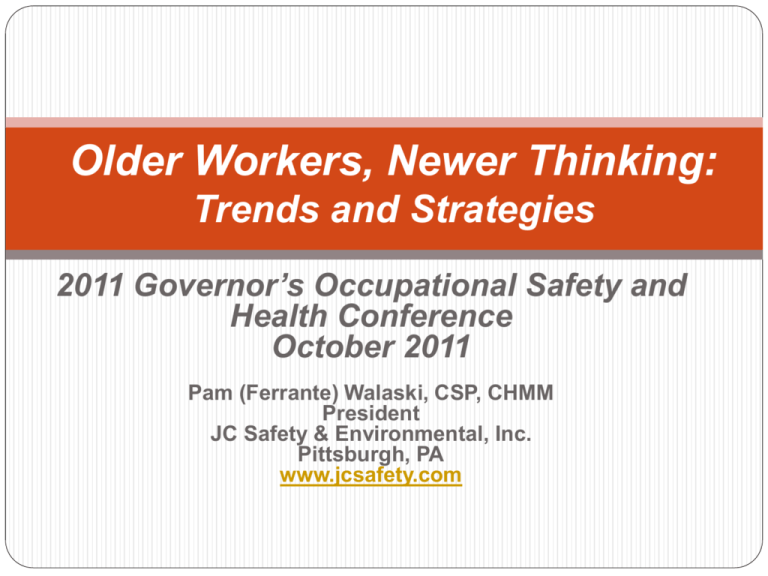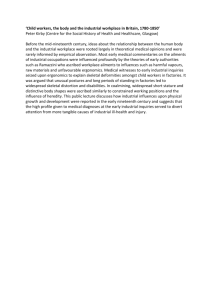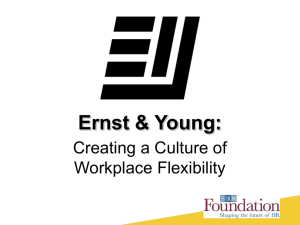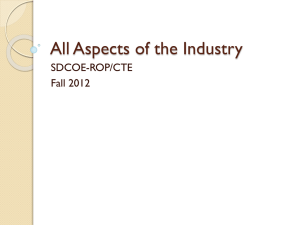Visual Changes
advertisement

Older Workers, Newer Thinking: Trends and Strategies 2011 Governor’s Occupational Safety and Health Conference October 2011 Pam (Ferrante) Walaski, CSP, CHMM President JC Safety & Environmental, Inc. Pittsburgh, PA www.jcsafety.com Where Do You Fit In? “Conceptions of “who is old” vary greatly across historical periods, and by industrial sector. We found that in the IT sector that workers are considered old if they have children. Ballet dancers and professional athletes may be considered old in their twenties or thirties, airline pilots in their fifties, and Supreme Court Justices in their eighties.” Victor Marshall, University of North Carolina 2 Copyright 2011 - JC Safety & Environmental, Inc. Where Do You Fit In? The American Age Discrimination Act uses 40 as an eligibility marker. WHO and the National Advisory Council on Aging uses age 45. You can join the AARP at age 50. 3 Copyright 2011 - JC Safety & Environmental, Inc. The Aging US Workforce United States Workforce Aged 55+ 16.2% of workforce in 2005 19.1% in 2012 23% by 2050. Between 1997-2007, employment of workers 65+ increased 101% (59% for employment of all ages) 4 Copyright 2011 - JC Safety & Environmental, Inc. The Aging US Workforce 55+ age group only one with an increase in labor participation rates since the late 1980s 30.3% - 1996 38% - 2006 40% of AARP members plan to work past 65 (or are already) 5 Copyright 2011 - JC Safety & Environmental, Inc. The Aging US Workforce We used to encourage retirement as a means to make room for the Baby Boomers – now we need to encourage the Baby Boomers to keep working because we don’t have enough people to replace them. 6 Copyright 2011 - JC Safety & Environmental, Inc. The Aging US Workforce Recent surveys indicate that 45% of HR professionals in private businesses feel that their workplaces are “just becoming aware” of issues related to the potential labor force shortages due to the retirement of Baby Boomers. SHRM Survey 2005 7 Copyright 2011 - JC Safety & Environmental, Inc. The Aging US Workforce With retirement funds devastated, the “about to retire” population must revise their plans and continue working. The “lost decade” (2000-2010) Those who had no retirement funds are in even worse shape. 8 Copyright 2011 - JC Safety & Environmental, Inc. The Aging US Workforce The result: Increase in older workers that are working because they have to despite their health or injury status. 9 Copyright 2011 - JC Safety & Environmental, Inc. Older Workers = Questions from the Field Are creating a “special class” of workers? Are we setting older workers up for inadvertent discrimination? Will older workers reject our efforts? Do they even “want” help? Have they learned ways to address the issue on their own? Are we seeing the result of years of EH&S programs that meet minimal benchmarks? 10 Copyright 2011 - JC Safety & Environmental, Inc. Aging is Normal Need clarity that the changes we see are “normal” and affect us all. Strategies/targeted initiatives benefit to all workers - none should cause harm/create more hazards for non-aging workers. Efforts should invoke the traditional approach of anticipation, recognition, evaluation and control. Responding to a hazard/incident pattern as we would to any other. 11 Copyright 2011 - JC Safety & Environmental, Inc. Aging is Normal Good Judgment Ability to adapt Long relationships with employer Years of experience System intelligence Ability to plan for the future Experienced in making decisions Sentient knowledge 12 Copyright 2011 - JC Safety & Environmental, Inc. Visual Changes Loss of elasticity of lens or lens yellows; more light required to see. Lens hardens, ciliary muscles get weaker eyes can’t change shape to focus as well or as quickly. 13 Copyright 2011 - JC Safety & Environmental, Inc. Visual Changes Additional light needed to see creates more glare. Harder to recover from glare. Nighttime legibility distances for a 60 year old is 2/3s that of a 25 year old. Copyright 2011 - JC Safety & Environmental, Inc. 14 Visual Changes Dynamic acuity (ability to see moving targets) reduced Contrast sensitivity reduced Phototrophic acuity decreased (light to dark transitions) 15 Copyright 2011 - JC Safety & Environmental, Inc. Visual Changes “Near point” gets further away - the closest an object can be and still in focus (presbyopia) 16 Age 20 = 4” Age 40 = 8.5” Copyright 2011 - JC Safety & Environmental, Inc. Visual Changes Higher rates of visual diseases such as macular degeneration, glaucoma and cataracts 17 Copyright 2011 - JC Safety & Environmental, Inc. Visual Changes Color vision deficiency – the ability to perceive cooler colors (blues and greens) is reduced. Copyright 2011 - JC Safety & Environmental, Inc. 18 Visual Changes Increased risk of Computer Vision Syndrome eyestrain, blurred distance or near vision, headaches, dry/red eyes, and double vision 19 Copyright 2011 - JC Safety & Environmental, Inc. Strategies and Solutions – Visual Changes Raise the level of illumination Indirect ambient light (40-50 footcandles) Variety of table and desk lamps Task lighting Additional overhead lighting Soft white lights that limit glare 20 Copyright 2011 - JC Safety & Environmental, Inc. Strategies and Solutions – Visual Changes Provide consistent, even light levels and gradual changes in light levels 21 Avoid pools of light – tripping hazard Uneven patterns produce shadows Transitions between outside/inside Use dimmers as often as possible Copyright 2011 - JC Safety & Environmental, Inc. Strategies and Solutions – Visual Changes Eliminate glare Minimizes falls Increases attention span Use focused task lighting Provide safety glasses with UV protection Copyright 2011 - JC Safety & Environmental, Inc. 22 Strategies and Solutions – Visual Changes Color and contrast High contrast enhances visual function Light entryways and walls/dark doorjambs and thresholds Edge of contrasting color on desk or edge of workstation countertop Desktops and countertops should stand out from floor. Critical machine parts – bright or contrasting colors 23 Copyright 2011 - JC Safety & Environmental, Inc. Strategies and Solutions – Visual Changes Improve visibility of stairs Most common place for falls, especially first/last step. Traction tape or glow-in-the dark tape Contrast step colors Handrails on both sides Copyright 2011 - JC Safety & Environmental, Inc. 24 Strategies and Solutions – Visual Changes For computer users: Avoid “bi-focal posture” Get computer glasses – better than bifocals Reduce glare – location of stations, antiglare screens Adjust brightness and contrast settings – same as work environment Pay attention to overall body posture 25 Screen should be 20-24” from eyes Top of screen at eye level Copyright 2011 - JC Safety & Environmental, Inc. Strategies and Solutions – Visual Changes For computer users: Work should have contrast between letters and background black on white is best aim for high contrast combinations avoid busy backgrounds and red font. “3-Bs” – Blink, Breathe and Break 20/20/20 Rule (Every 20 minutes look 20 feet away for 20 seconds) – relaxes the focusing muscle Lighted copy stands 26 Copyright 2011 - JC Safety & Environmental, Inc. Auditory Changes Presbycusis begins between age 35-40 Results in difficulty: tuning out background noises detecting simple, low intensity sound locating the source of the sound discriminating sounds when multiple noise sources are occurring. Copyright 2011 - JC Safety & Environmental, Inc. 27 Strategies and Solutions – Auditory Changes 28 Reduce overall level of noise and background noise with sound dampening products. Maintenance of equipment and machinery Assure that alarms/warning devices have both auditory and visual alarms. Assure that control panels use auditory and visual alarms as well. Think about training programs – can everyone hear? Add in visual clues Copyright 2011 - JC Safety & Environmental, Inc. Strategies and Solutions – Auditory Changes Implement a Hearing Conservation Program, even if not required Mandatory annual audiograms Reduce your “internal PEL” to 80-85. Copyright 2011 - JC Safety & Environmental, Inc. 29 Physical Capabilities Basic strength peaks at 30; declines thereafter. Decline is more rapid after 60, regardless of our overall physical condition. Copyright 2011 - JC Safety & Environmental, Inc. 30 Physical Capabilities 31 Muscle mass and elasticity Bone mass and degeneration of the spinal structures Control of posture stability Copyright 2011 - JC Safety & Environmental, Inc. Balance and coordination Ability to recover balance Speed of movement Ability to regulate body temperature Physical Capabilities Skin aging – less effective/efficient chemical barrier Metabolism changes - affects resistance to chemicals Degenerative arthritis - reduced mobility and increased chronic discomfort Reduced bone density – osteoporosis Heavy metal depository for bones 32 Copyright 2011 - JC Safety & Environmental, Inc. Physical Capabilities Shift work and overtime wreak havoc with older workers ability to recover Recession-based Retirement-fund based Proper rest decreases risk for MSDs 33 Copyright 2011 - JC Safety & Environmental, Inc. Strategies and Solutions – Physical Capabilities Provide opportunities for strength training – (on site gyms, fitness classes, morning stretches). Encourage employees to participate in fitness programs off work. Copyright 2011 - JC Safety & Environmental, Inc. 34 Strategies and Solutions – Physical Capabilities Is that lift really necessary? Look at tasks that require long reaches Install chain actuators for valve hand wheels, damper levers of other similar control devices Reduce ladder tasks by installing shallow angle stairways in place of ladders for regular elevated access 35 Copyright 2011 - JC Safety & Environmental, Inc. Strategies and Solutions – Physical Capabilities Defeat worker fatigue by: Color and decoration of work area Proper lighting Music Exercise Allow workers to control their environment with regard to breaks and temperature 6. More frequent, shorter breaks 7. Nap rooms (what?) 1. 2. 3. 4. 5. 36 Copyright 2011 - JC Safety & Environmental, Inc. Cognitive Changes Most findings related to cognitive losses have occurred in laboratory settings. Though the losses are real, we are not entirely sure how workers are affected in a real-life work setting. Copyright 2011 - JC Safety & Environmental, Inc. 37 Cognitive Changes Regardless of the cognitive changes, there is no evidence that our innate intelligence deceases as we age! Copyright 2011 - JC Safety & Environmental, Inc. 38 Cognitive Changes Short term memory is impaired Long term memory is reduced Decisions made more slowly, but the quality is not affected Ability to learn new material or skills slows Response time slows, especially as the task gets more complex Multi-tasking is more difficult 39 Copyright 2011 - JC Safety & Environmental, Inc. Strategies and Solutions – Cognitive Changes Make sure work areas and control panels are uncluttered Look at task series and see if they can’t be lengthened or multi-tasking can’t be reduced Increase decision-making time Minimize memory load – use lists and cheat sheets where possible 40 Copyright 2011 - JC Safety & Environmental, Inc. Strategies and Solutions – Cognitive Changes Older adults learn rely more on “crystallized intelligence” – knowledge of the world through experiencing it increases as we get older Copyright 2011 - JC Safety & Environmental, Inc. 41 Strategies and Solutions – Cognitive Changes Effective training: relates to past learning experiences encompasses smaller pieces of information provides for opportunities to practice – in class and shortly after returning to work utilizes frequent refreshers don’t forget to address any visual or auditory decrements Copyright 2011 - JC Safety & Environmental, Inc. 42 Strategies and Solutions – Cognitive Changes Use the “tribal knowledge” by having older workers become curriculum developers and co-trainers Craft a mentoring program that uses older workers as primary trainers Look for internal motivation to learn Audit your training program (not just evaluations) Look for observational proof that they retained the information 43 Copyright 2011 - JC Safety & Environmental, Inc. Areas of Impact Normal physical/cognitive changes in abilities and decrements lead to: Higher fatality rates Increase in falls Higher rates of CTDs/MSDs Higher severity rates Diagnostic difficulties due to co-morbidities 44 Copyright 2011 - JC Safety & Environmental, Inc. In the Workplace - Fatalities Fatalities by Age Group 16-24 25-34 35-44 45-54 55-64 65+ = = = = = = Percent of Total 7.6% 15.7% 20.0% 25.6% 18.6% 12.0% Percent of Workforce 13.6% 21.8% 21.7% 23.4% 15.1% 4.4% Source: BLS Data 2009/2010 45 Copyright 2011 - JC Safety & Environmental, Inc. In the Workplace - Falls 60% of ladder falls occur to workers >44 Fatal Falls: 15 to 44 - >15 feet 45+ - >7 feet 38% of fall fatalities are from older workers Copyright 2011 - JC Safety & Environmental, Inc. 46 In the Workplace - Falls Fall – occurs when a slip or trip stops you from maintaining your center of mass over your base of support 47 Copyright 2011 - JC Safety & Environmental, Inc. In the Workplace - Falls “Conservative gait pattern” – shorter step and stride, reduced ankle ROM, reduced speed (shuffle walk) Due to increase composition of body fat, declining muscle strength, musculoskeletal changes, and neurological changes 48 Copyright 2011 - JC Safety & Environmental, Inc. Strategies and Solutions – Falls Housekeeping, housekeeping, and more housekeeping!! Color contrast on ramps, surfaces, and stairs Reduce your facility’s fall protection minimum height Copyright 2011 - JC Safety & Environmental, Inc. 49 Strategies and Solutions – Falls Improve slip- resistance of flooring Mandatory slipresistance footwear Evaluate floor treatments and cleaning practices Copyright 2011 - JC Safety & Environmental, Inc. 50 Strategies and Solutions – Falls Balance exercise programs Provide balance flexibility Builds a strong core and improves lower body strength Keeps the slips and trips from becoming falls. Copyright 2011 - JC Safety & Environmental, Inc. 51 In the Workplace – Ergonomics Repetitive motion injury is the event with the highest median days away for all industries at 18. Sprains and strains accounted for 39% of injuries requiring days away from work. 45% of those injuries were from overexertion Overexertion accounted for 48% of injuries to those in health-care related occupations. BLS - 2009 52 Copyright 2011 - JC Safety & Environmental, Inc. In the Workplace – Ergonomics Carpal tunnel surgery – 2nd most common musculoskeletal surgery (>225,000/year) 23% of patients return to their previous positions 57% failure rate 53 Copyright 2011 - JC Safety & Environmental, Inc. In the Workplace – Ergonomics 25.1% of injuries reported to BLS/OSHA from overexertion $13.4B in costs Lifting, pushing, pulling, holding and throwing Many go unreported in early stages Symptoms go away Normal aches and pains Incentive programs? 54 Copyright 2011 - JC Safety & Environmental, Inc. Strategies and Solutions Ergonomics Follow these basic concepts: Adjust work surface heights – bring down or raise up Change work area layouts Provide foot rests Pad sharp surfaces or tool handles Rotate jobs or shorten shifts Limit overtime Increase frequency of breaks 55 Copyright 2011 - JC Safety & Environmental, Inc. Strategies and Solutions Ergonomics Consider the following evaluation tools to identify problem tasks/work areas: Washington State Ergonomic Checklists Rapid Upper Limb Assessment (RULA) Rapid Entire Body Assessment (REBA) NIOSH Lifting Guide Snook Push/Pull/Lift/Lower/Carry Tables Roger’s Fatigue Analysis 56 Copyright 2011 - JC Safety & Environmental, Inc. Strategies and Solutions Ergonomics Static stretching: Holding muscles/tendons in a still position for 15-30 seconds - usually done at the start of a shift or after lunch Has not been proven to reduce injury if done prior to physical activity American College of Sports Medicine recommends no static stretching prior to activity 57 Copyright 2011 - JC Safety & Environmental, Inc. Strategies and Solutions Ergonomics Dynamic stretching: Large active movements involving full ROM of joints Uses body's natural reflexes to stretch opposite muscle groups Lubricates joints Increases blood flow to the extremities Assists in preparing mind for work 58 Copyright 2011 - JC Safety & Environmental, Inc. Strategies and Solutions Ergonomics Both Have a Place Static stretching beneficial for muscle repair moves toxins out of the body done at end of activity or periodically throughout the day 59 Copyright 2011 - JC Safety & Environmental, Inc. Strategies and Solutions Ergonomics Both Have a Place Dynamic stretching Beneficial to lubricate joints Increase blood flow to extremities Prepare the mind/body for work Done before activities and at beginning of shift/after lunch/breaks 60 Copyright 2011 - JC Safety & Environmental, Inc. In the Workplace – Severe Injuries Median Days Away from Work 20-24 = 5 25-24 = 6 35-44 = 9 45-54 = 10 55-64 = 12 65+ = 15 All Workers = 8 61 Copyright 2011 - JC Safety & Environmental, Inc. Source: 2008 BLS Data In the Workplace – Severe Injuries 62 Copyright 2011 - JC Safety & Environmental, Inc. In the Workplace – Severe Injuries Percentage of Days Away from Work Cases Age Group % 11-20 Days All Ages 11.7 16-24 11.4 25-34 11.5 35-44 11.5 45-54 11.6 55-64 12.3 65+ 13.2 % 21-30 Days 6.8 10.3 6.2 7.0 7.4 7.6 8.3 % 31+ Days 26.0 14.3 20.9 27.6 30.1 32.9 35.6 Source: 2008 BLS Data 63 Copyright 2011 - JC Safety & Environmental, Inc. In the Workplace – Severe Injuries We have made great strides in the past 40 years at reducing injuries/illnesses But do we have it backwards? In our efforts to reduce frequency, have we neglected severity? With increase in costs and severity of injuries, we must revisit our methods particularly as the older workers begin to predominate our workforce 64 Copyright 2011 - JC Safety & Environmental, Inc. In the Workplace – Chronic Health Issues 133 million Americans have one or more chronic medical conditions 75% of all healthcare expenditures are for chronic medical conditions 60% of America adults are overweight or obese By 2013 more than 1 out of 4 dollars for personal consumption will be for health care 65 Copyright 2011 - JC Safety & Environmental, Inc. In the Workplace – Chronic Health Issues 1. 2. 3. 4. 5. 66 Heart disease 910,000 people die each year Cancer 1/3 from poor nutrition, no physical activity, overweight/obesity Stroke 1 million disabilities per year Chronic Respiratory Disease (COPD) 51% report work limitations Diabetes 88 million disability days per year Copyright 2011 - JC Safety & Environmental, Inc. Diabesity??? The Centers for Disease Control calls the increase an “epidemic”. Prevalence rates have doubled from 1990-2005 24 million as of 2007 (increase of 2 million in just 2 years) Pre-diabetes rates estimated at 57 million 8% of the total population; 25% of those 60+ 67 Copyright 2011 - JC Safety & Environmental, Inc. Increase in Obesity 1998 1990 2007 No Data 68 <10% 10%–14% 15%–19% Copyright 2011 - JC Safety & Environmental, Inc. 20%–24% 25%–29% ≥30% In the Workplace – Chronic Health Issues At onset of medical condition for workers between 51-60: ~25% left their jobs ~25% stopped working ~50% stayed at current jobs Of those who stayed accommodations were made for 29% of men and 37% of women Examples – alteration/assistance with job duties, change in schedule, shorter work day, more breaks 69 Copyright 2011 - JC Safety & Environmental, Inc. In the Workplace – Chronic Health Issues Co-morbidities: Makes diagnosis more difficult Harder to determine work-relatedness Makes actual treatment more complex and difficult Slow down the natural healing process 70 Copyright 2011 - JC Safety & Environmental, Inc. In the Workplace – Chronic Health Issues Employees will adapt to subtle changes in their health and capacity – sometimes without anyone noticing until….. a serious injury or illness occurs Sometimes the adaptations are healthy and beneficial, sometimes they are simply dangerous shortcuts 71 Copyright 2011 - JC Safety & Environmental, Inc. Strategies and Solutions Chronic Health Issues Despite the efforts of health prevention and health promotion – the health status of our population has not improved Wellness programs need to focus on prevention and disease management 72 Copyright 2011 - JC Safety & Environmental, Inc. Strategies and Solutions Chronic Health Issues Strong functional job descriptions that enable realistic evaluations by medical professionals Functional capacity evaluations tie it together Employers need both to begin to identify potential and reasonable accommodations 73 Copyright 2011 - JC Safety & Environmental, Inc. Strategies and Solutions Chronic Health Issues If there are options, injured/ill workers are less likely to force themselves to come back to their previous position/hours Migrate to less demanding jobs Provide options to acquire new skills “Red circle” a pay grade More flexible work schedules/hours, bridge employment, transitional opportunities 74 Copyright 2011 - JC Safety & Environmental, Inc. Older Workers, Newer Thinking: Trends and Strategies 2011 Governor’s Occupational Safety and Health Conference October 2011 Pam (Ferrante) Walaski, CSP, CHMM President JC Safety & Environmental, Inc. Pittsburgh, PA www.jcsafety.com








